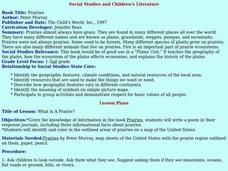Curated OER
Social Studies and Children's Literature
Young scholars write a journal in response to literature. The story that is read is about prairies. The subject of prairies becomes an object for research. The culminating activity is the making of a map where prairies exist in the...
Curated OER
Crab Lab
Learners participate in an activity in which they observe the behavior of a crab. In groups, they label and identify the function of each main part while observing and record their behavior. They make educated guesses on why they...
Curated OER
Christmas in Mexico
Learners identify how Christmas holidays are celebrated in Mexico, compare Mexican holidays with U.S. holidays, and learn Mexican customs. Lesson includes many downloadable activities to try with students.
Curated OER
Models of Philanthropy in the Lation Community
Students research the role of Latino Philanthropists. They examine the farm labor movement which started Latino activism. They find examples of good character and civic virtue within the Latino population.
Curated OER
"To Terraform or Not to Terraform?"
Learners analyze an article written by an engineer at NASA proposing colonizing Mars with human explorers on the fastest track possible. They are invited to react to the article through several activities.
Curated OER
Voices From Your Heart
Students create individual representations of Chinese calligraphy symbols in this cross-curricular lesson for the elementary Language Arts or Art classroom. One enrichment activity is included.
Curated OER
Sequencing a Chinese Folktale
Students sequence the events of the popular Chinese folktale "The Terrible Nung Gwama" using a graphic organizer. This lesson takes 45-minutes and includes two possible enrichment activities.
Curated OER
Origami
Students create paper cranes using the art of Origami from Japan as a basis. This lesson includes three lesson enrichment activities, a vocabulary list, and ideas for possible origami materials.
Curated OER
Introduction To Pests
Students investigate common pests and match pests to their respective pictures. In a group discussion, students explore the basic needs of pests and share personal pest stories. They examine common self-protection measures. Using the...
Curated OER
The African-American Struggle for Equality in the World War II Era
Students respect and appreciate the challenges people faced during World War II. They develop the different perspectives on race during WWII. Students develop that the nation's actions may not exemplify a nation's stated ideals. Students...
Curated OER
Elders As Resources
Students engage in a activity that uses discussion groups for communication. The focus of the activity is upon the respect for authority that should be given to older adults. Students engage in class discussion about the information that...
Curated OER
Destructive/Constructive Communication
Students are introduced to the characteristics of destructive and constructive communication. In groups, they send I-messages to other groups of examples of each. To end the lesson, they participate in role-play activities to practice...
Curated OER
VECTORS
Ninth graders explore vectors. In this vectors lesson students complete a lab activity.
Curated OER
Grow Your Character Bookmarks
Students make bookmarks out of seed paper to study the growth of seeds and complete an activity for the Six Pillars of Character. In this science and character instructional activity, students describe the stages of growth of plants and...
Curated OER
Encoded Meanings
Students explore symbols in art and complete related activities. In this art symbols lesson, students compare symbols they recognize to those of an African culture. Students create a collaborative work of art with symbols that have an...
Curated OER
Why do we Dream of a White Christmas?
Students examine a reading selection on how the idea of a white Christmas was developed. In this ESL lesson, students share a class discussion about the article then complete several assignments to reinforce what they learned, including...
Curated OER
Where My Peeps At?
Students conduct a series of activity that demonstrates Charles' and Boyle's Law. In this chemistry lesson, students determine the relationship among pressure, volume and temperature. They solve problems using mathematical equation.
Howard Hughes Medical Institute
Human Skin Color: Evidence for Selection
Skin color is controlled by at least six genes. Young scientists learn about skin colors through a documentary. They discuss the topics of pigment, natural selection, and vitamin D absorption. They apply their knowledge to higher order...
Teach Engineering
You Are There... First Flight
Glide into the study of flight. An engaging lesson plan has scholars research information on the Wright brothers. They develop props and produce a recreation of the first flight at Kitty Hawk. They then report on the event as if they...
Curated OER
Painted Lodges
Students explore lodge construction as a representation of culture. In this cultural diversity and Native American history lesson, students listen to a narrative explaining the origin of Native American painted lodges. Students design...
Missouri Department of Elementary
Other Changes (Life-Changing Events Outside of the Family)
Change is inevitable. Kindergarteners discuss coping skills to properly manage changes that can occur outside the family. Scholars reflect on their life changes after starting kindergarten. They discuss their feelings and draw a...
Howard Hughes Medical Institute
The Day the Mesozoic Died
While this is not the traditional, step-by-step lesson plan, it is chock-full of material that you can easily incorporate into your earth history unit. Its main purpose is to serve as a guide to using a three-part film, The Day the...
John F. Kennedy Center
Baila! Latin Dance in the Spanish Classroom
One, two, three. One, two, three. Invite your language learners to practice the steps for researching and presenting information. Each small group has the task of explaining one Latin dance in full detail.
Curated OER
Rainbow Friends
First graders recognize the colors of a rainbow. They explain the uniqueness of each person in the classroom. They work cooperatively with one another.
Other popular searches
- Respect Activities for Kids
- Hands on Activities Respect
- Respect Activities for Teens
- Hands on Respect Activities
- Self Respect Activities

























